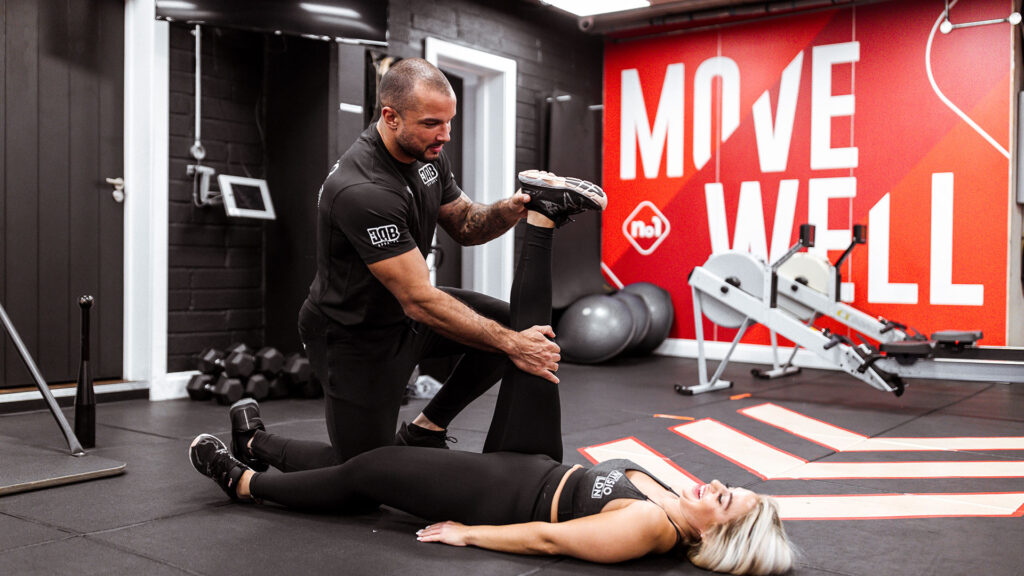Table of Contents
Main Takeaways
- When Surgery Helps: Recommended when conservative care (physiotherapy, meds) no longer relieves chronic or severe pain.
- Common Types:
- Total Knee Replacement (TKR): Replaces full joint; smart implants like Persona IQ offer real-time recovery data.
- Partial Replacement: Targets one compartment, preserving natural structure with quicker recovery.
- Arthroscopy: Minimally invasive; best for minor cartilage or meniscus issues.
- Osteotomy: Realigns bones for younger patients to delay replacement.
- Risks: Include infection, clots, implant issues, or post-op pain. Higher BMI and pre-surgery opioid use raise pain risk.
- Recovery Essentials: Early physiotherapy, tailored rehab, strength training, and pain management are key.
- Outcomes: Surgery improves mobility, quality of life, and independence when followed by structured rehab.
- Post-Op Care: Expert clinics like One Body LDN offer hands-on physiotherapy, deep tissue massage, and personalized exercise plans for optimal recovery.
Knee pain is a common affliction affecting millions worldwide, often stemming from injury, arthritis, or degenerative conditions. For many, conservative treatments such as physiotherapy or medication provide relief. However, when these options no longer suffice, knee surgery becomes a viable solution to restore mobility and improve quality of life. In the United States alone, over 600,000 knee replacement surgeries are performed annually, reflecting the procedure’s growing importance in orthopaedic care.
Advancements in surgical techniques and implant technology have made knee surgery safer and more effective than ever before. From partial to total knee replacements, patients now have tailored options to address their specific needs. This article explores the various types of knee surgery, associated risks, and the essential recovery and rehabilitation process, helping patients make informed decisions about their treatment journey through our knee pain treatment in London.
Types of Surgery
Knee surgery encompasses a range of procedures designed to alleviate pain and restore function. The choice of surgery depends on the severity of the knee condition, patient age, activity level, and overall health.

Total Knee Replacement (TKR): This is the most common surgical intervention for severe knee arthritis or damage. It involves replacing the entire knee joint with a prosthetic implant. The recent introduction of smart implants like Persona IQ—the first smart knee implant to receive FDA De Novo classification—marks a significant advancement. These implants provide real-time data to surgeons and patients, improving post-operative monitoring and outcomes. Additionally, the integration of artificial intelligence in these smart implants allows for personalized rehabilitation plans, adapting to the patient’s recovery pace and enhancing overall satisfaction with the surgical outcome.
Partial Knee Replacement: Suitable for patients with damage confined to a single compartment of the knee, this procedure replaces only the affected area, preserving more of the natural knee structure. It generally offers quicker recovery and less post-operative pain compared to total replacement. Patients often report a more natural feel in their knee post-surgery, which can significantly enhance their quality of life. Furthermore, advancements in surgical techniques and implant materials have improved the longevity of partial knee replacements, making them a viable option for many individuals who wish to maintain an active lifestyle.
Arthroscopic Surgery: A minimally invasive technique used to repair or remove damaged cartilage, meniscus tears, or loose bodies within the knee joint. It is often recommended for younger patients or those with less severe joint damage. The benefits of arthroscopic surgery include reduced scarring and a shorter recovery time, allowing patients to return to their daily activities more quickly. Surgeons can often perform this procedure on an outpatient basis, which further minimizes hospital stays and associated costs, making it an attractive option for many.
Osteotomy: This surgery involves cutting and reshaping the bones to relieve pressure on the knee joint, often used for younger, active patients with early-stage arthritis. By realigning the knee joint, osteotomy can help distribute weight more evenly across the joint, potentially delaying the need for more invasive procedures like total knee replacement. The procedure requires careful planning and imaging to ensure optimal alignment, and while recovery may take longer than arthroscopic surgery, the long-term benefits can be significant for maintaining mobility and function with support from specialist London knee pain physiotherapists.
Choosing the right type of surgery requires careful consultation with an orthopaedic specialist, considering both the clinical indications and patient lifestyle. Surgeons often use a multidisciplinary approach, collaborating with physiotherapists and rehabilitation specialists to create a comprehensive treatment plan tailored to the individual’s needs. This holistic view not only addresses the immediate surgical concerns but also considers long-term recovery and functional goals, ensuring that patients are well-informed and supported throughout their journey to recovery.
Risks and Complications
While knee surgery is generally safe, it carries potential risks and complications that patients should understand before proceeding. Common risks include infection, blood clots, implant loosening, and nerve damage. Post-operative pain is also a significant concern; a study from the Hospital for Special Surgery highlights that factors such as younger age, higher body mass index (BMI), and preoperative opioid use increase the risk of severe pain after knee replacement surgery.

Moreover, patients with comorbidities like rheumatoid arthritis—diagnosed in over 1.5 million Americans in 2022—may face additional challenges during recovery. It is essential for patients to disclose their full medical history and work closely with their surgical team to mitigate these risks. Additionally, those with diabetes or cardiovascular issues may experience slower healing times and increased complications, making it crucial to manage these conditions effectively before and after surgery.
Despite these concerns, knee replacements have been shown to significantly improve patients’ pain and well-being. Dr. Nicholas Michael Brown of Loyola Medicine emphasizes that these surgeries not only benefit patients but also enhance the quality of life for their spouses and families, underscoring the broader social impact of successful knee surgery.
Furthermore, advancements in surgical techniques, such as minimally invasive procedures and robotic-assisted surgeries, have contributed to reducing recovery times and improving outcomes. These innovations allow for smaller incisions, less trauma to surrounding tissues, and often result in a quicker return to normal activities, making the prospect of knee surgery less daunting for many patients.
It is also important to consider the psychological aspects of undergoing knee surgery. Many patients experience anxiety about the procedure and its aftermath, which can affect their overall recovery. Engaging in preoperative counseling or support groups can help alleviate some of these fears by providing patients with realistic expectations and coping strategies.
Understanding that pain management and rehabilitation are integral parts of the recovery process can empower patients, enabling them to take an active role in their healing journey.
Recovery and Rehabilitation
Recovery from knee surgery is a critical phase that determines the long-term success of the procedure. Rehabilitation typically begins soon after surgery and involves a combination of physiotherapy, exercise, and lifestyle adjustments to restore strength, flexibility, and function.

Physiotherapy plays a pivotal role in recovery. Expert clinics, such as those in London offering specialized post-operative care, provide tailored rehabilitation programs that include hands-on treatments, exercise therapy, and pain management strategies. These programs are designed to accelerate healing, reduce stiffness, and improve mobility, ensuring patients return to their daily activities safely and confidently.
Studies show that comprehensive rehabilitation not only benefits the patient but also improves the quality of life for their close family members, reflecting the interconnected nature of recovery. With the global knee replacement market projected to grow significantly—from USD 12 billion in 2025 to over USD 16 billion by 2030—advances in rehabilitation techniques continue to evolve, enhancing patient outcomes worldwide.
Patients are encouraged to engage actively in their recovery, adhering to prescribed exercises and attending regular physiotherapy sessions. Clinics like One Body LDN in London provide award-winning physiotherapy services, combining deep tissue massage and exercise rehabilitation to support patients through every stage of recovery. Additionally, many rehabilitation programs incorporate the use of modern technology, such as virtual reality and biofeedback, which can make exercises more engaging and help patients monitor their progress in real-time.
Moreover, nutrition plays a significant role in the recovery process. A well-balanced diet rich in anti-inflammatory foods can enhance healing and contribute to overall well-being. Patients are often advised to include plenty of fruits, vegetables, lean proteins, and healthy fats in their meals, which can help in reducing swelling and promoting tissue repair.
Furthermore, hydration is crucial; drinking adequate water aids in maintaining joint lubrication and can alleviate discomfort during the rehabilitation phase. As patients navigate their recovery journey, the integration of nutritional guidance alongside physical therapy can lead to more holistic and effective outcomes.
FAQ
What are the main types of knee surgery available?
The primary types include total knee replacement, partial knee replacement, arthroscopic surgery, and osteotomy. Each is suited to different conditions and patient needs. Total knee replacement involves replacing the entire knee joint with an artificial implant, making it ideal for patients with severe arthritis. Partial knee replacement, on the other hand, targets only the damaged part of the knee, preserving healthy tissue and offering a quicker recovery. Arthroscopic surgery is a minimally invasive procedure used for diagnosing and treating knee issues, such as torn ligaments or cartilage. Osteotomy, which involves reshaping the bones around the knee, is often recommended for younger patients with misalignment issues, allowing them to maintain an active lifestyle while delaying the need for a full replacement.
How long does recovery from knee replacement surgery take?
Recovery varies but generally takes several weeks to months. Initial physiotherapy begins soon after surgery, with gradual improvement in mobility and strength over time. Patients typically stay in the hospital for a few days post-surgery, during which pain management and initial rehabilitation are prioritized. After discharge, a structured physiotherapy program is crucial, often involving exercises to strengthen the muscles around the knee and improve range of motion. Many patients can return to light activities within six weeks, but full recovery may take up to six months or longer, depending on individual health factors and adherence to rehabilitation protocols.
What are the risks associated with knee surgery?
Risks include infection, blood clots, implant issues, and post-operative pain. Certain factors like higher BMI and preoperative opioid use can increase pain risk after surgery. Additionally, nerve damage, stiffness, and persistent swelling are potential complications that can affect recovery. It’s essential for patients to discuss these risks with their surgeon, who can provide tailored advice and strategies to mitigate them. Preoperative assessments often include blood tests and imaging to identify any underlying conditions that could complicate surgery, ensuring that patients are well-informed and prepared for the procedure.
Can knee surgery improve quality of life?
Yes, knee surgery has been shown to significantly reduce pain and improve mobility, benefiting both patients and their families. Many individuals report a marked improvement in their ability to perform daily activities, such as walking, climbing stairs, and participating in recreational sports. The psychological benefits are also noteworthy, as alleviating chronic pain can lead to enhanced mood and overall well-being. Furthermore, improved mobility can foster social interactions and encourage a more active lifestyle, contributing to better physical health and emotional resilience.
Is physiotherapy necessary after knee surgery?
Physiotherapy is essential for optimal recovery, helping restore function, reduce pain, and prevent complications. A tailored physiotherapy regimen focuses on strengthening the muscles surrounding the knee, enhancing flexibility, and improving balance. Sessions may include manual therapy, guided exercises, and modalities such as ultrasound or electrical stimulation to promote healing. Patients are often encouraged to engage in home exercises to complement their therapy sessions, and regular follow-ups with physiotherapists ensure that progress is monitored and adjustments are made as needed to maximize recovery outcomes.
Are there new advancements in knee replacement technology?
Yes, smart implants like Persona IQ offer enhanced monitoring and personalized care, representing a new frontier in knee replacement surgery. These advanced devices can track a patient’s movement and activity levels, providing valuable data to both the patient and their healthcare team. Innovations such as 3D printing are also revolutionizing the customization of implants, allowing for a more precise fit based on an individual’s anatomy. Furthermore, robotic-assisted surgery techniques are gaining traction, enabling surgeons to perform procedures with greater accuracy and potentially leading to quicker recovery times and improved long-term outcomes.
How common is knee replacement surgery?
In the U.S., over 600,000 knee replacement surgeries are performed annually, reflecting its widespread use for managing severe knee conditions. The increasing prevalence of knee replacements is attributed to factors such as an aging population, rising obesity rates, and greater awareness of treatment options. As more individuals seek relief from chronic pain and limitations caused by knee disorders, the demand for these surgeries continues to grow. Additionally, advancements in surgical techniques and post-operative care have contributed to higher success rates, making knee replacement a viable option for many patients looking to regain their quality of life.
Can younger patients undergo knee replacement?
Yes, but factors such as age, activity level, and overall health are considered. Partial replacements or osteotomies may be preferred for younger individuals. Surgeons often assess the patient’s lifestyle and future activity goals when determining the best surgical approach. For younger patients, preserving as much natural joint structure as possible is crucial, as they may require additional surgeries in the future. Education about the importance of maintaining a healthy weight and engaging in low-impact exercises can also play a significant role in the long-term success of knee surgery for younger patients.
What role does BMI play in knee surgery outcomes?
Higher BMI is linked to increased risk of severe post-operative pain and complications, so weight management is often recommended before surgery. Studies have shown that patients with a lower BMI tend to experience better surgical outcomes, including shorter recovery times and fewer complications. Surgeons may suggest preoperative weight loss programs or nutritional counseling to help patients achieve a healthier weight prior to surgery. This proactive approach not only enhances surgical success but also contributes to improved overall health, making it easier for patients to engage in physical therapy and rehabilitation post-surgery.
How can I find expert physiotherapy for knee surgery recovery in London?
Clinics like One Body LDN offer award-winning physiotherapy services with highly trained specialists at our physiotherapy clinic in London, providing personalized rehabilitation plans to support recovery. These clinics often employ a multidisciplinary approach, incorporating physiotherapists, nutritionists, and exercise physiologists to ensure comprehensive care.
Many facilities also provide access to state-of-the-art equipment and technology, enhancing the rehabilitation experience. Patients can benefit from tailored exercise programs that align with their specific recovery goals, ensuring a more effective and supportive path to regaining strength and mobility after knee surgery.
See our guide on knee pain bending for related insights.
Start Your Recovery Journey with One Body LDN
If you’re struggling with knee pain and considering surgery, the path to recovery doesn’t end when you leave the operating room. At One Body LDN, voted as the best London physio clinic, we understand the importance of expert post-operative care. Our award-winning team of physiotherapists, including former athletes, ex-Team GB members, and NHS specialists, are dedicated to providing personalized rehabilitation plans with a professional knee pain physiotherapist that address the root cause of your pain. Specializing in musculoskeletal physiotherapy and sports injuries, we’re equipped to support corporate office workers and athletes alike. With a commitment to never oversell treatments, we focus on results-based therapy to have you feeling amazing. Don’t let your knee surgery be the end of your journey to wellness. Book your free initial assessment at our clinic today and take the first step towards a pain-free life with the most trusted physiotherapy experts in London.
References


